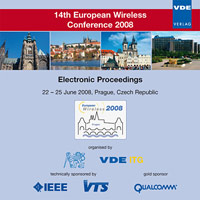Multiple Antenna Techniques for Downlink Interference Mitigation in Cellular Networks
Konferenz: European Wireless 2008 - 14th European Wireless Conference
22.06.2008 - 25.06.2008 in Prague, Czech Republic
Tagungsband: European Wireless 2008
Seiten: 5Sprache: EnglischTyp: PDF
Persönliche VDE-Mitglieder erhalten auf diesen Artikel 10% Rabatt
Autoren:
Olsson, Magnus; Skillermark, Per (Ericsson Research, Stockholm, Sweden)
Inhalt:
In this paper, multiple antenna based intercell interference mitigation techniques are studied in the downlink of an OFDM-based cellular radio network. At the base stations, multiple antennas are used for transmit beamforming in order to reduce the intercell interference spatially spread in the network. At the user terminals, multiple receive antennas facilitate implementation of interference rejecting baseband signal processing techniques, e.g. the well-known interference rejection combining (IRC). Evaluations are performed by means of system level simulations. The results show that both transmit beamforming by itself as well as terminal interference rejection by itself provide significant gains, both in terms of system throughput as well as cell edge user throughput. However, the real performance boost comes when the techniques are used together, they combine very well and the gains are almost additive. The reasons for this are two; first, the transmit beamforming reduces the intercell interference considerably. Second, when the user yet is exposed for interference, it consists most probably of one or few dominating sources, which is exactly the situation where interference rejection algorithms such as IRC are most efficient.


